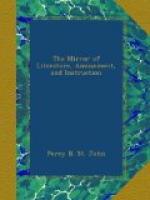* * * * *
OLD CHARING CROSS.
[Illustration: OLD CHARING CROSS.]
This is one of the celebrated memorials of the affection of Edward I. for his beloved Elinor, being the cross erected on the last spot on which the body rested in the way to Westminster Abbey, the place of sepulture. This and all the other crosses were built after the designs of Cavilini; and all of them were destroyed by the zeal of the Reformers.
Our illustration is from an engraving copied from a print found in a mutilated genealogy published in 1602, relative to the Stuart family, in which were portraits of James I. and family, and a print of Old St. Paul’s. Pennant, speaking of Old Charing Cross, says “from a drawing communicated to me by Dr. Combe, it was octagonal, and in the upper stage had eight figures; but the Gothic parts were not rich.” The above print differs from this drawing, yet it was evidently intended to represent the same subject, “Charing Cross” being engraved at the bottom.
The site of the cross is now occupied by the Equestrian Statue of Charles I. in which the figure and symmetry of the horse are beautifully displayed. Indeed, it is said to be the most finished piece of workmanship of the kind ever produced: that of Marcus Aurelius, or the two horses on the Monte Cavallo, or Quirino at Rome not excepted.
* * * * *
NOTES OF A READER.
* * * * *
ODD MISTAKE.
Judge Hall says, “I once travelled through Illinois when the waters were high; and when I was told that Little Mary would stop me, and that to get by Big Mary was impossible, I supposed them to be attractive damsels, who, like beauteous Circe of old, amused themselves with playing tricks upon travellers. But, lo! instead of blushing, blooming, and melodious maids, I found torrents cold as ice, and boisterous as furies. Mary is too sweet a name to be thus profaned.”




